国际贸易 名词解释中英文 自己整理
国际贸易英文术语中英对照

(1)FCA (Free Carrier) 货交承运人(2)FAS (Free Alongside Ship) 装运港船边交货(3)FOB (Free on Board) 装运港船上交货(4)CFR (Cost and Freight) 成本加运费(5)CIF (Cost,Insurance and Freight) 成本、保险费加运费(6)CPT (Carriage Paid To) 运费付至目的地(7)CIP (Carriage and Insurance Paid To) 运费、保险费付至目的地(8)DAF (Delivered At Frontier) 边境交货(9)DES (Delivered Ex Ship) 目的港船上交货(10)DEQ (Delivered Ex Quay) 目的港码头交货(11)DDU (Delivered Duty Unpaid) 未完税交货(12)DDP (Delivered Duty Paid) 完税后交货主要船务术语简写:(1)ORC (Origen Recevie Charges) 本地收货费用(广东省收取)(2)THC (Terminal Handling Charges) 码头操作费(香港收取)(3)BAF (Bunker Adjustment Factor) 燃油附加费(4)CAF (Currency Adjustment Factor) 货币贬值附加费(5)YAS (Yard Surcharges)码头附加费(6)EPS (Equipment Position Surcharges) 设备位置附加费(7)DDC (Destination Delivery Charges) 目的港交货费(8)PSS (Peak Season Sucharges) 旺季附加费(9)PCS (Port Congestion Surcharge) 港口拥挤附加费(10)DOC (DOcument charges) 文件费(11)O/F (Ocean Freight) 海运费(12)B/L (Bill of Lading) 海运提单(13)MB/L(Master Bill of Lading) 船东单(14)MTD (Multimodal Transport Document) 多式联运单据(15)L/C (Letter of Credit) 信用证(16)C/O (Certificate of Origin) 产地证(17)S/C (Sales Confirmation)销售确认书(Sales Contract) 销售合同(18)S/O (Shipping Order)装货指示书(19)W/T (Weight Ton)重量吨(即货物收费以重量计费)(20)M/T (Measurement Ton)尺码吨(即货物收费以尺码计费)(21)W/M(Weight or Measurement ton)即以重量吨或者尺码吨中从高收费(22)CY (Container Yard) 集装箱(货柜)堆场(23)FCL (Full Container Load) 整箱货(24)LCL (Less than Container Load) 拼箱货(散货)(25)CFS (Container Freight Station) 集装箱货运站(26)TEU (Twenty-feet Equivalent Units) 20英尺换算单位(用来计算货柜量的多少)(27)A/W (All Water)全水路(主要指由美国西岸中转至东岸或内陆点的货物的运输方式)(28)MLB(Mini Land Bridge) 迷你大陆桥(主要指由美国西岸中转至东岸或内陆点的货物的运输方式)(29)NVOCC(Non-Vessel Operating Common Carrier) 无船承运人出口国交货的贸易术语三组E 组:E.W.X.,工厂交货。
国际贸易名词解释

国际贸易(International Trade)名词翻译第一章全球中的贸易1.进口import2.出口export3.商品贸易merchandise goods4.服务出口service exports5.移民migration6.对外直接投资foreign direct investment7.贸易差额trade balance8.贸易顺差trade surplus9.贸易逆差trade deficit10.双边贸易差额bilateral trade balance11.国内生产总值gross domestic product12.进口关税import tariffs 13.进口配额import quotas14.贸易壁垒trade barriers15. 逆纵向reverse—vertical16.横向horizontal 17.纵向vertical第二章贸易与技术李嘉图模型17.技术technolony 18.资源resources 19.外包outsourcing20.邻接性proximity 21.李嘉图模型Ricardian model22.贸易模式trade pattern23.自由贸易区free-trade area24.自然资源natural resources25.劳动力资源labor resources25.资本capital26.生产要素f actors of production27.绝对优势absolute advantage28.比较优势comparative advantage29.边际劳动产出marginal product of labor30.生产可能性边界production possibilities frontier31.机会成本opportunity cost32.无差异曲线i ndifference curve33.效用utility34.相对价格relative price34.国际贸易均衡international trade equilibriu m35.世界价格线world price line 36.贸易所得gains from trade37.出口供给曲线export supply curve38.进口需求曲线import demand curve39.贸易条件terms of trade第三章特定要素模型中的贸易得失40.特定要素模型specific-factors model 41.收益递减diminishing returns42.自给自足autarky 43.贸易禁运embargo 44.实际工资real wage45.贸易调整救济Trade Adjustment Assistance46.服务services47.资本租金rental on capital48.地租rental on land49.名义保护系数nominal protection coefficient第四章无第五章国家间的劳动力与资本流动50.雷布钦斯定理Rybczynski theorem51.要素价格不敏感性factor price insensitivity52.实际增加值real value-added53.充分移民条件下的均衡equilibrium with full migration第六章规模收益递增与不完全竞争54.差异性产品differentiated 55.不完全竞争imperfect competition56.垄断竞争monopolistic competition57.规模收益递增increasing returns to scale58.规模经济economies of scale 59.产业内贸易intra-industry trade60.引力方程gravity equation61.区域性贸易协定regional trade agreements 62.倾销dumping63.双头垄断duopoly64.边际收入marginal revenue65.边际成本marginal cost66.垄断利润monopoly profits67.自由贸易协定free-trade agreements68.产业内贸易指数index of intra-industry69.边界效应border effects 70.关税tariff 71.配额quotas72.价格歧视price discrimination73.反倾销税antidumping duty74.歧视性垄断discriminating monopoly75.相互倾销reciprocal dumping第七章产品与服务外包76.境外外包foreign outsourcing 77.商业服务business services78.离岸offshoring 79.价值链value chain80.技能偏向型技术变迁skill-biased technological change81.工资总额total wage payments82.等产量线isoquants第八章完全竞争条件下的进口关税与配额83.贸易政策trade policy84.倾销dumping85.出口补贴export subsidies86.保障条款safeguard provision87.免责条款escape clause88.关税同盟customs unions89.消费者剩余consumer surpius 90.生产者剩余producer surplus91.小国small country 92.无谓损失deadweight loss93.生产损失(效率损失)production loss 94.消费损失sumption loss95.争端解决程序dispute settlement procedure96.关税战tariff war97.大国large country98.贸易条件terms of trade99.贸易条件利得terms-of-trade gain 100.最优关税optimal tariff 101.多种纤维协定Multifibre Arrangement 102.等效进口关税equivalent import tariff103.配额租quota rents 104.配额许可证quota licenses105.寻租rent seeking 106.“自愿”出口限制“voluntary”exportrestrain t107.“自愿”限制协议“voluntary”restraint agreement第九章不完全竞争条件下的进口关税与配额108.幼稚产业infant industry 109.市场势力market power110.边际收益marginal revenue 111.外部性externality112.知识外溢knowledge spillover 113.市场失灵market failure114.反补贴税countervailing duty 115.保障性关税safeguard tariff第十章农业与高科技产业的出口补贴116.出口补贴export subsidy117.共同农业政策Common Agricultural Policy118.间接补贴indirect subsidies119.国内农业支持domestic farm supports120.生产补贴production subsidy121.瞄准原理targeting principle 122.外部性externality123.战略优势strategic advantage124.双头垄断duopoly125.博弈论game theory126.支付矩阵payoff matrix127.纳什均衡Nash equilibrium128.先动者优势first mover advantage第十一章国际协定:贸易、劳工与环境129.多边协定multilateral agreement130.最惠国原则most favored nation principle131.囚徒困境prisoner’s dilemma132.特惠贸易协定preferential trade agreements133.原产地规则rules of orign134.贸易创造trade creation 135.贸易转移trade diversion136.劳工标准labor standards 137.最低生活工资living wage138.多边贸易协定multilateral environment agreements139.公地悲剧tragedy for the commons140.公共财产common property141.《京都议定书》《Kyoto Protocol》。
国际贸易实务术语总结

国际贸易实务术语总结国际贸易实务术语总结1:出口1.1 出口商(Exporter)出口商是指从一个国家或地区将产品或服务销售到另一个国家或地区的企业或个人。
1.2 出口贸易(Export Trade)出口贸易是指出口商将产品或服务销售到其他国家或地区,并从中获取收入的商业活动。
1.3 货物出口(Goods Export)货物出口是指出口商将实际物品出口到其他国家或地区进行销售。
1.4 服务出口(Service Export)服务出口是指出口商将服务项目(如技术支持、咨询等)提供给其他国家或地区的客户并从中获取收入。
2:进口2.1 进口商(Importer)进口商是指从一个国家或地区购买产品或服务并引入另一个国家或地区的企业或个人。
2.2 进口贸易(Import Trade)进口贸易是指进口商购买产品或服务并引入本国或地区,为本国或地区提供商品和服务的商业活动。
2.3 货物进口(Goods Import)货物进口是指进口商购买其他国家或地区生产的实际物品,并将其引入本国或地区。
2.4 服务进口(Service Import)服务进口是指进口商购买其他国家或地区提供的服务项目,并引入本国或地区使用。
3:国际贸易条件(Incoterms)国际贸易条件是由国际商会(ICC)制定的一套国际贸易术语,规定了进口和出口交货中各方的权利和责任,包括责任的划分、货物交付的时间和地点以及相关费用的分担等。
4:海关术语4.1 海关(Customs)海关是负责管理和监督进出口商品、物品和信息的机构。
4.2 进口关税(Import Duty)进口关税是指进口商品需缴纳的税费,由进口商支付给海关。
4.3 出口关税(Export Duty)出口关税是指出口商品需缴纳的税费,由出口商支付给海关。
4.4 进口限制(Import Restrictions)进口限制是指针对某些特定产品实施的限制或禁止进口的政策措施。
4.5 出口限制(Export Restrictions)出口限制是指针对某些特定产品实施的限制或禁止出口的政策措施。
国际贸易双语版的名词解释
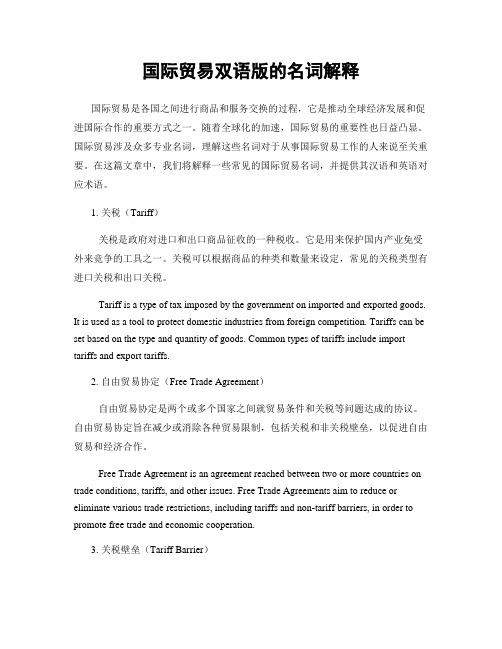
国际贸易双语版的名词解释国际贸易是各国之间进行商品和服务交换的过程,它是推动全球经济发展和促进国际合作的重要方式之一。
随着全球化的加速,国际贸易的重要性也日益凸显。
国际贸易涉及众多专业名词,理解这些名词对于从事国际贸易工作的人来说至关重要。
在这篇文章中,我们将解释一些常见的国际贸易名词,并提供其汉语和英语对应术语。
1. 关税(Tariff)关税是政府对进口和出口商品征收的一种税收。
它是用来保护国内产业免受外来竞争的工具之一。
关税可以根据商品的种类和数量来设定,常见的关税类型有进口关税和出口关税。
Tariff is a type of tax imposed by the government on imported and exported goods. It is used as a tool to protect domestic industries from foreign competition. Tariffs can be set based on the type and quantity of goods. Common types of tariffs include import tariffs and export tariffs.2. 自由贸易协定(Free Trade Agreement)自由贸易协定是两个或多个国家之间就贸易条件和关税等问题达成的协议。
自由贸易协定旨在减少或消除各种贸易限制,包括关税和非关税壁垒,以促进自由贸易和经济合作。
Free Trade Agreement is an agreement reached between two or more countries on trade conditions, tariffs, and other issues. Free Trade Agreements aim to reduce or eliminate various trade restrictions, including tariffs and non-tariff barriers, in order to promote free trade and economic cooperation.3. 关税壁垒(Tariff Barrier)关税壁垒指的是通过设定高额关税或其他限制措施,以限制或阻碍他国商品进入本国市场的手段。
国际贸易名词解释

1.国际贸易(International Trade) :指世界各国之间货物、服务及贸易相关的要素交换的活动,2.是各国之间劳动分工的表现形式。
对外贸易(Foreign Trade):指一个国家或地区与其他国家或地区进行的商品和劳务的交换活动。
3.海外贸易(Oversea Trade):一些海岛国家或地区将其对外贸易称为海外贸易。
4.对外贸易额(Value of Foreign Trade):以金额表示的一国对外贸易规模的指标。
对外贸易总额= 进口总额+出口总额一般:Σ各国出口贸易额反映国际贸易规模5.对外贸易量(Quantum of Foreign Trade):指以不变价格计算的反映贸易规模的指标。
对外贸易量= 对外贸易额/ 价格指数6.对外贸易地理方向(地区分布):在一定时期内,一个国家的出口商品流向和进口商品来源,常用一国对各国或地区的贸易额占该国对外贸易总额的比例反映。
7. 国际贸易地理方向(地区分布):世界各洲、各国或各个集团在国际贸易中所占的地位。
常用各国或地区的贸易额占世界贸易总额的比例反映。
8.对外贸易依存度(Y):也称对外贸易系数或开放指数Y=(Σ进口额+Σ出口额)/GNP或GDPGNP(国民生产总值)GDP(国内生产总值)9.对外贸易货物结构:一定时期内,一国进出口贸易中各类货物的构成;10.对外贸易货物结构:一般以制成品、半制成品、初级产品在该国对外贸易中所占的比例反映11.贸易条件= 出口商品价格/进口商品价格12.贸易条件指数= 出口商品价格指数/进口商品价格指数13.过境交付: 即服务者提供者和消费者都不跨越国境14.境外消费:即服务消费者到服务提供者国内接受服务15.商业存在:服务企业到国外开办服务场所,提供服务16.自然人流动: 一国自然人到服务消费者所在国或第三国提供服务17.市场经济需要对外贸易:①商品生产的发展需要国际贸易:②社会化大生产需要国际贸易:社会化大生产的根本特点:分工的深化和交换的扩大18.关境:关境是一个国家海关法规全部生效的领域。
国际贸易实务术语总结
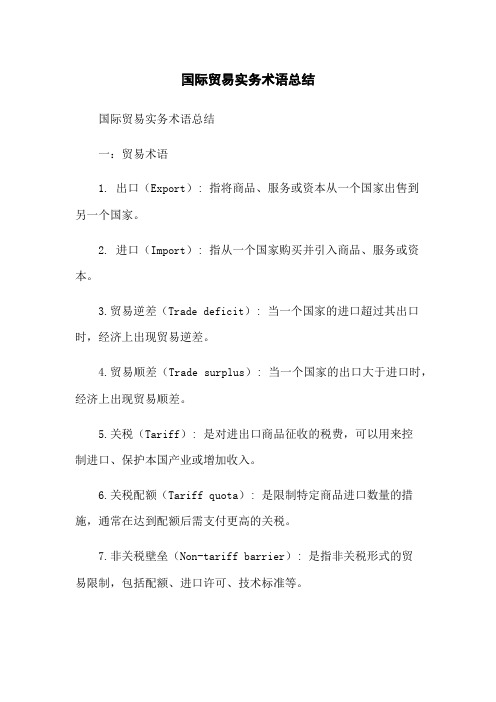
国际贸易实务术语总结国际贸易实务术语总结一:贸易术语1. 出口(Export): 指将商品、服务或资本从一个国家出售到另一个国家。
2. 进口(Import): 指从一个国家购买并引入商品、服务或资本。
3.贸易逆差(Trade deficit): 当一个国家的进口超过其出口时,经济上出现贸易逆差。
4.贸易顺差(Trade surplus): 当一个国家的出口大于进口时,经济上出现贸易顺差。
5.关税(Tariff): 是对进出口商品征收的税费,可以用来控制进口、保护本国产业或增加收入。
6.关税配额(Tariff quota): 是限制特定商品进口数量的措施,通常在达到配额后需支付更高的关税。
7.非关税壁垒(Non-tariff barrier): 是指非关税形式的贸易限制,包括配额、进口许可、技术标准等。
8.自由贸易区(Free Trade Area): 是指一组国家通过降低或取消关税和非关税壁垒来促进自由贸易的区域。
9.关税同盟(Customs Union): 是自由贸易区的一种更深度的一体化形式,成员国在对外贸易时实行统一的关税政策。
10.最惠国待遇(Most Favoured Nation treatment): 是指一个国家给予其他国家的最优惠贸易条件,不能对某个国家给予更好的贸易待遇。
二:国际支付术语1.信用证(Letter of Credit): 是银行以买方为指示人,在购买商品后为卖方提供保付款项的文件。
2.跟单信用证(Documentary Letter of Credit): 除了支付任务,还要求卖方提供与货物相关的文件,如提单、装箱单等。
3.保函(Bank Guarantee): 是银行为了保证某人或企业履行合同、支付款项等义务而出具的书面保证。
4.电汇(Telegraphic Transfer): 是一种通过银行电子转账方式进行的国际支付。
5.托收(Collection): 是一种付款方式,出口商通过银行要求进口商支付,银行收取费用并帮助卖方收款。
国际贸易名词解释

1.国际贸易:国际贸易亦称 "世界贸易",泛指国际间商品和劳务的交换,它由各国(地区)的对外贸易构成,是世界各国对外贸易的总和。
2.对外贸易:对外贸易亦称 "国外贸易"或 "进出口贸易",是指一个国家(地区)同另一个国家(地区)之间的商品和劳务的交换。
3.对外贸易值:是以货币表示的一国对外贸易金额的大小,又称对外贸易额。
4.对外贸易量:为剔除价格变动对以货币表示的对外贸易额的影响,准确地反映一国对外贸易的实际规模,往往用一定年份为基期计算的进口价格或出口价格指数去除以当时的进口总额或出口总额,得到相当于按不变价格计算的进口额或出口额,通过这种方法计算出来的单纯反映对外贸易的量,就叫对外贸易量。
5.总贸易:是指以国境为标准划分的进出口贸易。
6.专门贸易:是指以关境为标准划分的进出口贸易。
7.贸易差额:是指一定时期内一国出口总额与进口总额之间的差额。
8.有形货物贸易:是指有形的、实物形态的、可以看见的货物的贸易。
9.服务贸易:依世贸组织《服务贸易总协定》的定义,服务贸易指:(1)从成员境内向任何其他成员境内提供服务(2)从一成员的境内向任何其他成员的服务消费者提供服务(3)一成员的服务提供者以自然人的存在在任何其他成员境内提供服务(4)一成员的服务提供者在任何其他成员境内以商业性存在提供服务。
10.直接贸易:是指货物生产国与货物消费国不通过第三国进行买卖货物的行为。
11.间接贸易:是指货物生产国与货物消费国通过第三国进行买卖货物的行为。
12.转口贸易:货物生产国与货物消费国通过第三国进行的贸易,对第三国来说,则是转口贸易。
13.对外贸易商品结构:是指一国在一定时期内进出口贸易中各种商品的构成,即某大类或某种商品进出口贸易与整个进出口贸易额之比,以份额表示。
14.国际贸易商品结构:是指一定时期内各大类商品或某种商品在整个国际贸易中的构成,即各大类或某种商品贸易额与整个国际贸易额相比,用比重表示。
国际贸易理论与实务名词解释
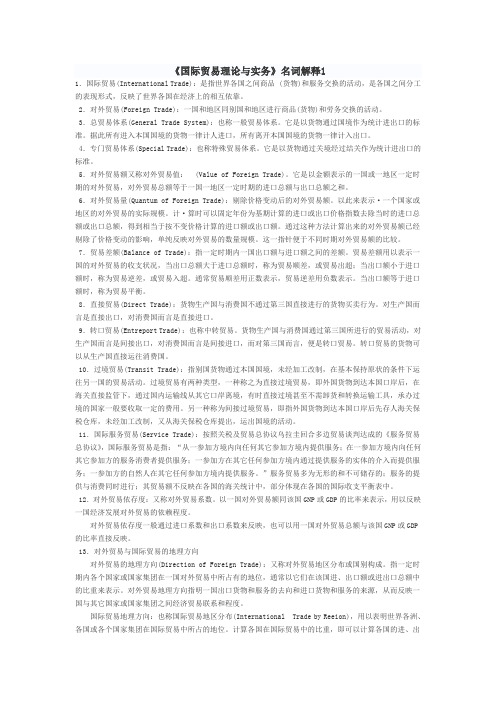
《国际贸易理论与实务》名词解释11.国际贸易(International Trade):是指世界各国之间商品 (货物)和服务交换的活动,是各国之间分工的表现形式,反映了世界各国在经济上的相互依靠。
2.对外贸易(Foreign Trade):一国和地区同别国和地区进行商品(货物)和劳务交换的活动。
3.总贸易体系(General Trade System):也称一般贸易体系。
它是以货物通过国境作为统计进出口的标准。
据此所有进入本国国境的货物一律计人进口,所有离开本国国境的货物一律计入出口。
4.专门贸易体系(Special Trade):也称特殊贸易体系。
它是以货物通过关境经过结关作为统计进出口的标准。
5.对外贸易额又称对外贸易值: (Value of Foreign Trade)。
它是以金额表示的一国或一地区一定时期的对外贸易,对外贸易总额等于一国一地区一定时期的进口总额与出口总额之和。
6.对外贸易量(Quantum of Foreign Trade):剔除价格变动后的对外贸易额。
以此来表示·一个国家或地区的对外贸易的实际规模。
计·算时可以固定年份为基期计算的进口或出口价格指数去除当时的进口总额或出口总额,得到相当于按不变价格计算的进口额或出口额。
通过这种方法计算出来的对外贸易额已经剔除了价格变动的影响,单纯反映对外贸易的数量规模。
这一指针便于不同时期对外贸易额的比较。
7.贸易差额(Balance of Trade):指一定时期内一国出口额与进口额之间的差额。
贸易差额用以表示一国的对外贸易的收支状况,当出口总额大于进口总额时,称为贸易顺差,或贸易出超;当出口额小于进口额时,称为贸易逆差,或贸易入超。
通常贸易顺差用正数表示,贸易逆差用负数表示。
当出口额等于进口额时,称为贸易平衡。
8.直接贸易(Direct Trade):货物生产国与消费国不通过第三国直接进行的货物买卖行为。
对生产国而言是直接出口,对消费国而言是直接进口。
国际贸易名词解释英文及简答论述期末考试复习

《国际贸易》英文名词解释International Trade(国际贸易)International trade is the international exchange of goods and services between countries. This type of trade gives rise to a world economy, in which prices, or supply and demand, affect and are affected by global events.Free Trade(自由贸易)The main idea of free trade is that supply and demand factors, operating on a global scale, will ensure that production happens efficiently. Therefore, nothing needs to protect or promote trade and growth because market forces will do so automatically.Protectionism(贸易保护主义)In contrast, protectionism holds that regulation of international trade is important to ensure that markets function properly. Advocates of this theory believe that market inefficiencies may hamper the benefits of international trade and they aim to guide the market accordingly. Production Possibilities Curve /Frontier(生产可能性曲线/边界)A Production Possibilities Frontier is a graph that shows the various combinations of output that the economy can possibly produce, given the available factors of production and the existing technology . Opportunity Cost(机会成本)Opportunity Cost means whatever must be given up to obtain some item. Supply Curve(供给曲线)A Supply Curve is a graph that shows the relationship between the price of a good and the quantity supplied.Demand Curve (需求曲线)A Demand Curve is a graph that describes the relationship between the price of a good and the quantity demanded.Excess Supply Curve(出口供给曲线)Because Excess Supply is a situation in which quantity supplied is greater than quantity demanded, Excess Supply Curve can be defined as a graph that depicts the relationship between the price and the available quantity for export of a product. Excess Supply Curve can be derived from subtracting a supply curve with a corresponding demand curve. Excess Demand Curve(进口需求曲线)Because Excess Demand is a situation in which quantity demanded is greater than quantity supplied, Excess Demand Curve can be defined as a graph that depicts the relationship between the price and the desirable quantity for import of a product. Excess Demand Curve can be derived from subtracting a demand curve with a corresponding supply curve. Consumer Surplus(消费者剩余)Consumer Surplus means a buyer’s willingness to pay minus the amount the buyer actually pays. Consumer surplus measures the benefit to buyersof participating in a market.Producer Surplus (生产者剩余)Producer Surplus is the amount a seller is paid for a good minus the seller’s cost. Producer surplus measures the benefit to sellers of participating in a market.Economies of Scale(规模经济)Economies of Scale means the property whereby the long-run average cost falls as the quantity of output increases.Diseconomies of Scale(规模不经济)Diseconomies of Scale means the property whereby the long-run average cost rises as the quantity of output increases.Constant Returns to Scale(规模报酬不变)Constant Returns to Scale means the property whereby the long-run average cost stays the same as the quantity of output changes. Indifference Curve(无差异曲线)Indifference Curve is a curve that shows consumption bundles that give the consumer the same level of satisfaction.The Gravity Model(引力模型)In its basic form, the gravity model assumes that only size and distance(经济规模和距离) are important for trade in the following way:Tij = A x Yi x Yj /Dij两国之间的贸易规模与经济规模成正比,与两国之间的距离成反比。
国际贸易专业术语解释

国际贸易专业术语解释1. “FOB(Free on Board),就是船上交货呀!比如说,你要出口一批货物,在货物装上船那一刻,责任就从你转移到买家啦!这就好像接力比赛,你把接力棒交到对方手里,后面的路就靠他们啦!”2. “CIF(Cost, Insurance and Freight),成本、保险加运费哟!好比你是卖家,不仅要负责货物的成本,还要买好保险,把货物安全送到目的地,就像是你给货物买了张一路平安的票呢!比如你卖东西给国外客户,用CIF 术语,你就得把这些都安排好呀!”3. “EXW(Ex Works),工厂交货呀!这就相当于你在自己工厂门口就把货物交给买家啦,之后的事情都由他们搞定,是不是很简单直接?就像你把做好的蛋糕放在店门口,顾客自己来拿走就行啦!”4. “FCA(Free Carrier),货交承运人呢!想象一下,你把货物交给运输公司的那个人,这时候责任就转移啦!就如同你把包裹交给快递员,之后就看快递员的啦!比如你和对方约定 FCA,你把货交给承运人就完成任务咯!”5. “CPT(Carriage Paid To),运费付至呀!就是说你要承担把货物运到指定地点的运费呢!这就好像你给朋友寄东西,你付了邮费一样,只不过这个距离更远啦!比如你要把货物运到某个地方,用 CPT 术语,你得把运费掏了哦!”6. “CIP(Carriage and Insurance Paid To),运费、保险费付至呢!哇塞,这就不仅要付运费,还要买保险哦!就像你送贵重物品给别人,不仅要付运费让它到对方那里,还要买保险以防万一呀!比如你用 CIP 术语,这些都得安排妥妥的!”7. “DAT(Delivered at Terminal),运输终端交货呀!就是货物到了指定的运输终端,责任就转移啦!好比你送东西到快递驿站,到了那里你就完成任务了呢!比如说你和对方约定 DAT,货物到了那个终端,你就可以松口气啦!”8. “DAP(Delivered at Place),目的地交货呢!这可厉害啦,要把货物送到指定的地点哟!就像你给朋友送礼物,直接送到他家门口一样!比如你用 DAP 术语,得把货物一路护送到目的地哦!”9. “DDP(Delivered Duty Paid),完税后交货呀!这可是最厉害的一个,你要承担所有的责任和费用,包括关税啥的!就像你给别人准备了一份超级豪华大礼包,什么都包了!比如你答应 DDP,那可真得把一切都搞定呀!”10. “L/C(Letter of Credit),信用证哟!这就像是给买家和卖家之间的一个保障,银行做担保呢!比如说买家开个信用证,卖家就放心发货,不用担心收不到钱啦!是不是很靠谱呢?”我的观点结论就是:这些国际贸易专业术语都很重要呀,搞清楚它们,才能在国际贸易中少走弯路,顺利完成交易呢!。
国际贸易名词解释英文及简答论述 期末考试复习

《国际贸易》英文名词解释International Trade(国际贸易)International trade is the international exchange of goods and services between countries. This type of trade gives rise to a world economy, in which prices, or supply and demand, affect and are affected by global events.Free Trade(自由贸易)The main idea of free trade is that supply and demand factors, operating on a global scale, will ensure that production happens efficiently. Therefore, nothing needs to protect or promote trade and growth because market forces will do so automatically.Protectionism(贸易保护主义)In contrast, protectionism holds that regulation of international trade is important to ensure that markets function properly. Advocates of this theory believe that market inefficiencies may hamper the benefits of international trade and they aim to guide the market accordingly. Production Possibilities Curve /Frontier(生产可能性曲线/边界)A Production Possibilities Frontier is a graph that shows the various combinations of output that the economy can possibly produce, given the available factors of production and the existing technology . Opportunity Cost(机会成本)Opportunity Cost means whatever must be given up to obtain some item.Supply Curve(供给曲线)A Supply Curve is a graph that shows the relationship between the price of a good and the quantity supplied.Demand Curve (需求曲线)A Demand Curve is a graph that describes the relationship between the price of a good and the quantity demanded.Excess Supply Curve(出口供给曲线)Because Excess Supply is a situation in which quantity supplied is greater than quantity demanded, Excess Supply Curve can be defined as a graph that depicts the relationship between the price and the available quantity for export of a product. Excess Supply Curve can be derived from subtracting a supply curve with a corresponding demand curve.Excess Demand Curve(进口需求曲线)Because Excess Demand is a situation in which quantity demanded is greater than quantity supplied, Excess Demand Curve can be defined as a graph that depicts the relationship between the price and the desirable quantity for import of a product. Excess Demand Curve can be derived from subtracting a demand curve with a corresponding supply curve.Consumer Surplus(消费者剩余)Consumer Surplus means a buyer’s willingness to pay minus the amount the buyer actually pays. Consumer surplus measures the benefit to buyers of participating in a market.Producer Surplus (生产者剩余)Producer Surplus is the amount a seller is paid for a good minus the seller’s cost. Producer surplus measures the benefit to sellers of participating in a market.Economies of Scale(规模经济)Economies of Scale means the property whereby the long-run average cost falls as the quantity of output increases.Diseconomies of Scale(规模不经济)Diseconomies of Scale means the property whereby the long-run average cost rises as the quantity of output increases.Constant Returns to Scale(规模报酬不变)Constant Returns to Scale means the property whereby the long-run average cost stays the same as the quantity of output changes. Indifference Curve(无差异曲线)Indifference Curve is a curve that shows consumption bundles that give the consumer the same level of satisfaction.The Gravity Model(引力模型)In its basic form, the gravity model assumes that only size and distance(经济规模和距离) are important for trade in the following way:Tij = A x Yi x Yj /Dij两国之间的贸易规模与经济规模成正比,与两国之间的距离成反比。
国际贸易英语知识点总结

国际贸易英语知识点总结一、国际贸易术语(Incoterms)1. FOB (Free on Board)- 含义:卖方在指定的装运港将货物装上买方指定的船只后,卖方即完成交货义务。
风险在货物越过船舷时转移给买方。
- 示例:We offer the goods FOB Shanghai.(我们提供上海港船上交货价的货物。
)- 相关费用:卖方负责将货物运至装运港船上之前的一切费用,包括国内运输、装卸等费用;买方负责从装运港到目的港的运费、保险费等。
2. CIF (Cost, Insurance and Freight)- 含义:卖方负责支付货物成本、保险费和运费,将货物运至指定目的港。
- 示例:The price is quoted CIF New York.(价格报的是纽约港到岸价。
)- 相关费用:卖方承担货物到达目的港之前的成本、保险费和运费;买方负责卸货后的费用,如进口关税等。
风险在货物越过装运港船舷时转移给买方。
3. CFR (Cost and Freight)- 含义:卖方负责货物成本和运费,将货物运至指定目的港。
与CIF相比,不包含保险费。
- 示例:We can supply the goods CFR London.(我们可以供应伦敦港成本加运费价的货物。
)- 相关费用:卖方承担货物运至目的港的成本和运费,买方负责保险费及卸货后的费用。
风险在货物越过装运港船舷时转移给买方。
二、商务信函写作。
1. 信头(Letterhead)- 包含公司名称、地址、联系方式(电话、传真、电子邮箱等)。
- 例如:ABC Company.123 Main Street, New York, NY 10001.Tel: +1 - 212 - 1234567.Fax: +1 - 212 - 1234568.Email:*******************.2. 称呼(Salutation)- 如果知道对方姓名,用“Dear Mr./Ms. + 姓氏”,如“Dear Mr. Smith”;如果不知道具体姓名,可用“Dear Sir/Madam”或者“To Whom It May Concern”。
国际贸易名词解释汇总

国际贸易名词解释汇总国际贸易是指不同国家或地区之间的商品、服务和资本的跨国流动。
在进行国际贸易时,我们常常会遇到一些特定的词汇和术语。
本文将对一些常见的国际贸易名词进行解释和总结,帮助读者更好地了解和运用这些术语。
1. 贸易逆差(Trade Deficit)- 贸易逆差指一个国家或地区的进口超过了出口,导致经常账户出现赤字。
一个国家的贸易逆差通常意味着其对外支付了更多的资金,可能导致货币贬值和经济不稳定。
2. 贸易顺差(Trade Surplus)- 贸易顺差指一个国家或地区的出口超过了进口,导致经常账户出现盈余。
一个国家的贸易顺差通常意味着其对外收入超过了支出,可能导致其货币升值和经济增长。
3. 关税(Tariff)- 关税是一种国家对进口商品征收的税收。
通过设置关税,一个国家可以增加进口商品的成本,以刺激本国产业的发展或者保护国内市场。
4. 非关税壁垒(Non-tariff Barrier)- 非关税壁垒是指除了关税以外的其他形式的限制和障碍,如配额、进口许可证、质量标准等。
非关税壁垒常被用来限制进口,保护本国产业。
5. 最惠国待遇(Most Favored Nation Treatment)- 最惠国待遇是世界贸易组织(WTO)成员国给予其他成员国的一种贸易优惠待遇。
即一个国家对某个贸易伙伴国实施的优惠待遇,也必须同样适用于其它所有的WTO成员国。
6. 自由贸易区(Free Trade Zone)- 自由贸易区是指一组国家或地区为了促进贸易自由化和经济合作而形成的区域。
在自由贸易区内,成员国之间通常实施零关税或减少贸易壁垒,以促进贸易流动和经济发展。
7. 关务联盟(Customs Union)- 关务联盟是在自由贸易区基础上更深一步的一种经济一体化形式。
成员国在关税政策上保持一致,并对非成员国实行共同的关税政策。
典型的关务联盟包括欧盟和东盟。
8. 保护主义(Protectionism)- 保护主义是一种通过实施贸易限制措施保护本国产业免受外国竞争的政策。
国际贸易的名词解释
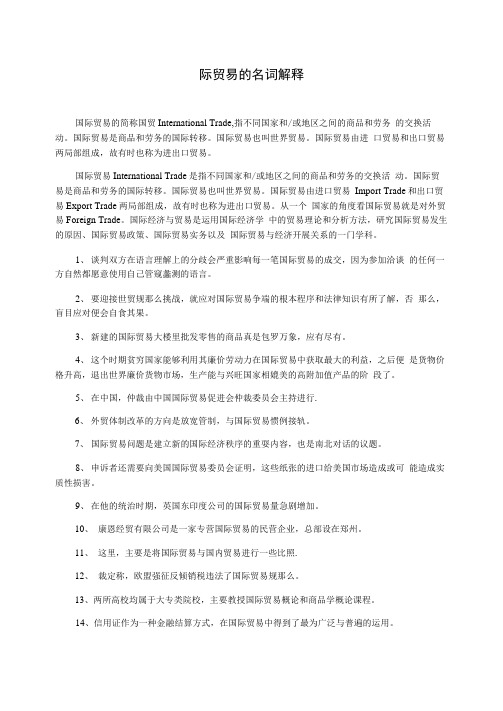
际贸易的名词解释国际贸易的简称国贸International Trade,指不同国家和/或地区之间的商品和劳务的交换活动。
国际贸易是商品和劳务的国际转移。
国际贸易也叫世界贸易。
国际贸易由进口贸易和出口贸易两局部组成,故有时也称为进出口贸易。
国际贸易International Trade是指不同国家和/或地区之间的商品和劳务的交换活动。
国际贸易是商品和劳务的国际转移。
国际贸易也叫世界贸易。
国际贸易由进口贸易Import Trade和出口贸易Export Trade两局部组成,故有时也称为进出口贸易。
从一个国家的角度看国际贸易就是对外贸易Foreign Trade。
国际经济与贸易是运用国际经济学中的贸易理论和分析方法,研究国际贸易发生的原因、国际贸易政策、国际贸易实务以及国际贸易与经济开展关系的一门学科。
1、谈判双方在语言理解上的分歧会严重影响每一笔国际贸易的成交,因为参加洽谈的任何一方自然都愿意使用自己管窥蠡测的语言。
2、要迎接世贸规那么挑战,就应对国际贸易争端的根本程序和法律知识有所了解,否那么,盲目应对便会自食其果。
3、新建的国际贸易大楼里批发零售的商品真是包罗万象,应有尽有。
4、这个时期贫穷国家能够利用其廉价劳动力在国际贸易中获取最大的利益,之后便是货物价格升高,退出世界廉价货物市场,生产能与兴旺国家相媲美的高附加值产品的阶段了。
5、在中国,仲裁由中国国际贸易促进会仲裁委员会主持进行.6、外贸体制改革的方向是放宽管制,与国际贸易惯例接轨。
7、国际贸易问题是建立新的国际经济秩序的重耍内容,也是南北对话的议题。
8、申诉者还需要向美国国际贸易委员会证明,这些纸张的进口给美国市场造成或可能造成实质性损害。
9、在他的统治时期,英国东印度公司的国际贸易量急剧增加。
10、康恩经贸有限公司是一家专营国际贸易的民营企业,总部设在郑州。
11、这里,主要是将国际贸易与国内贸易进行一些比照.12、裁定称,欧盟强征反倾销税违法了国际贸易规那么。
国际贸易实务名词翻译

国际贸易实务:名词解释53个汇总名词解释1.bartertrade(易货贸易):the direcrt exchang e ofgoods or service s-without an interve ning mediumof exchang e or momey-eithera ccordi ng to establi shed rates of exchang e or by bargain ing.it is conside redthe oldestform of trade.2.directtrade(直接贸易):goods are transpo rteddi rectly from the product ion country to the consumi ng country. In this case,only two parties are involve d in the transac tion,namelythe exporte r and theimpo rter.3.entrepo t trade:refersto the transac tion which involve s importi ng goods from oversea sfor further process ing or assembl ing and then reexpor ting the goods abroad. Entrepo ttrade involve s only one party, who is the importe r, the process or and at thesame time also the exporte r.4.invisib letrad e(无形贸易):没有实物形态的技术和服务的进出口。
国际贸易名词解释

国际贸易名词解释1.国际贸易(Internationale Trade) 是指世界各国(或地区)之间商品和劳务的交换活动,是各国在国际分工的基础上相互联系的主要形式,反映了世界各国在经济上的相互联系与依赖的关系。
2.净出口(净进口)是指一国(或地区)在一定时期内(一般以一年度计算),在同种商品上既有进口也有出口,当出口数大于(或小于)进口数时称之。
3.复出口(复进口)是指国外(本国)商品进口(出口)后未经加工制造又出口(进口)。
4.贸易条件:一般指出口商品价格与进口商品价格之间的比率,又称“进出口交换比价”或“交换比价”。
由于所涉及的是一个国家的种类繁多的所有进出口商品的价格,固常用贸易条件指数。
5.对外贸易量:指用进出口商品的计量单位(如数量、重量等)表示的反映贸易规模的指标。
它可以剔除价格波动的影响,是世界贸易组织和大多数国家采用来衡量贸易规模的指标。
6.对外贸易依存度:是一个国家在一定时期内进出口贸易值与该国同期国民(国内)生产总值(GNP、GDP)的对比关系。
是衡量一个国家国民经济发展对对外贸易依赖程度的一个指标,可细分为进口与出口对外依存度7.过境贸易(Transit Trade)指贸易货物在运输途中经过一国国境,这些货物既不在该国销售,该国也不参与到贸易之中,只是提供交通的便利,并收取少量费用。
8.转口贸易(Entreport Trade )转口贸易是指一国(或地区)进口某种商品不是以消费为目的,而是将它作为商品再向别国出口的贸易活动。
9.国际分工(International Division of Labor):是指世界各国(地区)之间的劳动分工,是各国生产者通过世界市场形成的劳动联系,也是国际贸易和各国(地区)经济联系的基础。
它还是各国民经济发展到一定阶段,国民经济内部分工超越国家界限发展的结果,同时也是生产社会化向国际化发展的趋势。
10.资源禀赋:是指一国自然拥有地各种生产要素(通常指土地、劳动、资本)的数量。
国际贸易概念术语
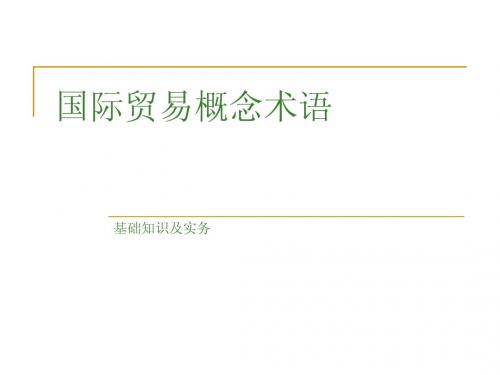
直接贸易和转口贸易
(一)直接贸易(Direct Trade) 直接贸易是"间接贸易"的对称,是指商品生产国与商 品消费国直接卖买商品的行为. (二)间接贸易(Indirect Trade) 间接贸易是"直接贸易"的对称,也称转口贸易. 是指商品生产国与商品消费国通过第三国进行卖买商品 的行为.其中,生产国是间接出口;消费国是间接进口; 第三国是转口.转口贸易(Entrepot Trade)是指生产国 与消费国之间通过第三国所进行的贸易.即使商品直接 从生产国运到消费国去,只要两者之间并未直接发生交 易关系,而是由第三国转口商分别同生产国与消费国发 生的交易关系,仍然属于转口贸易范畴.
3,信用证(Letter of Credit)
信用证(L/C)是开证银行根据进口商的要求和提示 或代表其自身,开给出口商(受益人)的,在单证相 符的条件下承诺支付汇票或发票金额的文件. 信用 证的特点 (1)开证银行应开证申请人的要求而开立; (2)付款人为银行; (3)是以合同为基础,独立于合同的契约; (4)是银行的单据业务.
运费及保险费付至(CIP)
本术语英文为Carriage and Insurance Paid to(… named place of destination), 即 运费及保险费付至(……指定目的地).它指卖 方除负有与运费付至(……指定目的地)术语相 同的义务外, 卖方还须办理货物在运输途中 应由买方承担的货物灭失或损坏风险的海运保 险并支付保险费. 本术语适用于任何运输方 式.
托收
付款交单——即期D/P at sight 买方应凭卖方开具的即期跟单汇票,于见票时立 即付款,付款后交单. 付款交单——远期D/P after sight 买方对卖方开具的见票后××天付款的跟单汇票, 于提示时应即予承兑,并应于汇票到期日即予付款, 付款后交单. 承兑交单D/A 买方对卖方开具的见票后天付款的跟 单汇票,于提示时应即承兑,并应于汇票到期日即予 付款.承兑后交单.承兑交单并不意味买方到期一定 付款,这取决于买方的信誉.
国际贸易名词解释
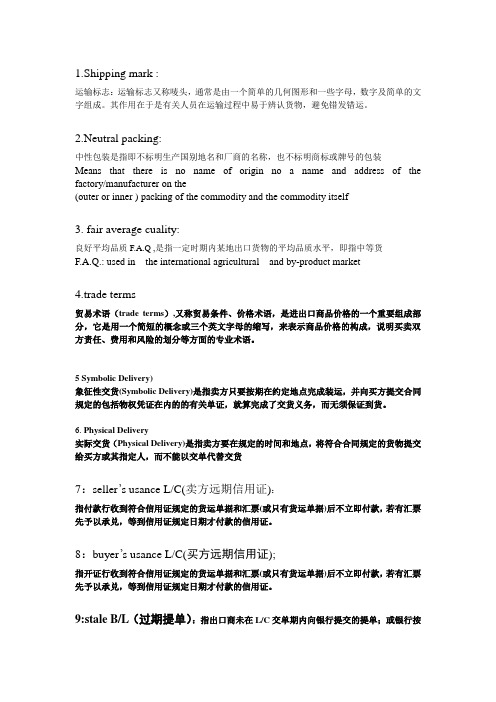
1.Shipping mark :运输标志:运输标志又称唛头,通常是由一个简单的几何图形和一些字母,数字及简单的文字组成。
其作用在于是有关人员在运输过程中易于辨认货物,避免错发错运。
2.Neutral packing:中性包装是指即不标明生产国别地名和厂商的名称,也不标明商标或牌号的包装Means that there is no name of origin no a name and address of the factory/manufacturer on the(outer or inner ) packing of the commodity and the commodity itself3. fair average cuality:良好平均品质F.A.Q ,是指一定时期内某地出口货物的平均品质水平,即指中等货F.A.Q.: used in the international agricultural and by-product market4.trade terms贸易术语(trade terms),又称贸易条件、价格术语,是进出口商品价格的一个重要组成部分,它是用一个简短的概念或三个英文字母的缩写,来表示商品价格的构成,说明买卖双方责任、费用和风险的划分等方面的专业术语。
5 Symbolic Delivery)象征性交货(Symbolic Delivery)是指卖方只要按期在约定地点完成装运,并向买方提交合同规定的包括物权凭证在内的的有关单证,就算完成了交货义务,而无须保证到货。
6. Physical Delivery实际交货(Physical Delivery)是指卖方要在规定的时间和地点,将符合合同规定的货物提交给买方或其指定人,而不能以交单代替交货7:seller’s usance L/C(卖方远期信用证):指付款行收到符合信用证规定的货运单据和汇票(或只有货运单据)后不立即付款,若有汇票先予以承兑,等到信用证规定日期才付款的信用证。
国贸名词解释参考版完整版

第一章1.国际贸易:是指世界各国(或地区 )之间在商品和服务方面的交换活动,它是各个国家(或地区 )在国际分工的基础上相互联系的主要形式。
2.对外贸易:如果从单个国家(或地区 )的角度出发,一个特定的国家( 或地区 )同其他国家(或地区 ) 之间所进行的商品和服务的交换活动。
3.海外贸易:对一些海岛国家(或地区)以及对外贸易活动主要依靠海运的国家(或地区),如英国、日本、台湾省等,把对外贸易称为海外贸易。
4.净出口与净进口:在一定时期内(通常一年),将某种商品的出口数量和进口数量加以比较,如果出口量大于进口量,则为净出口;如果出口量小于进口量,则为净进口。
净出口和净进口是以数量来反映的一国某种商品在国际贸易中所处的地位。
5.出口部门:一国能够将产品销往国际市场的各类产业的总和。
6.进口竞争部门:一国与进口产品在本国市场上进行竞争的各类产业的总和。
7.总贸易:以国境作为统计对外贸易的标准。
凡是进入该国境界的商品一律列为进口,称为总进口;凡是离开该国境界的商品均列为出口,称为总出口。
总进口额加上总出口额就是一国的总贸易额。
8.专门贸易:以关境作为统计对外贸易的标准。
外国商品进入关境之后才列为进口,称为专门进口。
凡是离开关境的商品都要列为出口,称为专门出口。
专门出口额加上专门进口额,即是一个国家的专门贸易额9.贸易差额:在一定时期内 (通常为一年 ),一个国家的出口总值与进口总值之间的差额。
如果出口值大于进口值,就是存在出超,或称贸易顺差;反之,若是进口值大于出口值称为入超,或存在贸易逆差。
10.国际贸易值:用货币来表示的一定时期内各国的对外贸易总值,它能反映出某一时期内的贸易总金额。
第二章1.国际分工:指各国在从事商品生产时,相互间实行的劳动分工和产品分工,它是社会分工向国际范围扩展的结果。
国际分工是国际贸易和世界市场的基础。
2.垂直型国际分工:指发达国家进口原材料、出口工业制成品,发展中国家进口工业制成品、出口原材料的国际分工。
- 1、下载文档前请自行甄别文档内容的完整性,平台不提供额外的编辑、内容补充、找答案等附加服务。
- 2、"仅部分预览"的文档,不可在线预览部分如存在完整性等问题,可反馈申请退款(可完整预览的文档不适用该条件!)。
- 3、如文档侵犯您的权益,请联系客服反馈,我们会尽快为您处理(人工客服工作时间:9:00-18:30)。
国际贸易名词解释中英文自己整理成本差异的原因是:不同的国家有不同的要素禀赋;生产不同的商品需要不同的要素密度。
因此,不同国家在不同商品的生产上才会有相对的优势。
结论:一个国家应该出口那些密集地使用其供应充裕和价格低廉的要素生产的商品,进口那些密集地使用其供应稀缺和价格昂贵的要素生产的商品,才能从贸易中获利。
古典贸易理论:机会成本(opportunity cost):生产某种产品而必须放弃的能够生产除此以外最大可获收益的产品的代价。
The amount of another item must be given up in order to release sufficient resources to produce one more unit of a given item.机会成本不变的存在需要两个条件:第一,两种产品生产中所使用的要素比例固定不变,并且可以相互替代;第二,所有产品中使用的同一要素都是同质的。
国际分工(International Division of Labor):指世界上各国(地区)之间的劳动分工,是各国生产者通过世界市场形成的劳动联系,是国际贸易和各国(地区)经济联系的基础。
Division of labor or specialization is the specialization of cooperative labor in specific, circumscribed tasks and roles, intended to increase the productivity of labor.完全分工Complete Specialization: The utilization of all of a nation’s resources in the production of only one commodity with trade. This usually occurs under constant costs. 不完全分工Incomplete Specialization: The continued production of both commodities in both nations with increasing costs.绝对优势(absolute advantage)各国间存在的生产技术上的差别,以及由此造成的劳动生产率和生产成本的绝对差别,是国际分工和国际贸易的基础。
各国应集中生产并出口具有“绝对优势”的产品,进口其不具有“绝对优势”的产品,其结果比自己什么都生产更有利。
比较优势(comparative advantage)绝对成本理论比较成本理论 The law of comparative cost The nation with the lower opportunity cost in the production of a commodity has a comparative advantage in that commodity.H-O model要素禀赋理论要素密集度Factor Intensity要素密度是指生产某种商品时,与生产另一种商品相比,所投入两种生产要素的比例。
这是一个相对的概念,与生产要素的绝对投入量无关。
It measures the input ratio of product factors in the production.要素丰裕度Factor Abundance要素充裕度是指一国所拥有的两种生产要素的相对比例。
这是一个相对的概念,与其所拥有的生产要素的绝对数量无关。
It measures the relative abunda nce of one nation’s economic resources.贸易条件要素价格均等化理论The Factor-Price Equalization Theorem特定要素模型斯托尔珀-萨缪尔森定理里昂惕夫之谜产业内贸易及其原因产业外贸易(intra-industry trade)在同一时期内既进口又出口属于同一产业的产品。
产业内贸易指数(index of intra-industrial trade,IIT)测度一个产业的产业内贸易程度。
内部规模经济外部规模经济重叠需求理论人均收入水平接近的国家需求结构存在重叠之处,可能会消费相同类型的制成品。
技术差距理论(Technology Gap Theory)各国技术发展情况不一致,就可能产生技术垄断。
产品生命周期理论(Product Life Cycle Theory)是关于产品生命不同阶段决定生产与出口该产品的国家转移理论,是一种动态经济理论。
恩格尔效应恩格尔定理随着家庭和个人收入增加,收入中用于食品方面的支出比例将逐渐减小罗伯津斯基定理(the Rybczynski Theorem)假定一个国家只生产两种产品,在商品价格固定不变的前提下,某一生产要素的增长将导致密集使用该要素部门的生产增加,使密集使用其他要素部门的生产下降。
The theorem postulates that at constant prices, an increase in the endowment of one factor will increase by a greater proportion the output of the commodity intensive in that factor and will reduce the output of the other commodity.荷兰病(Dutch Disease):一个行业的增长扩张导致其他行业的萎缩。
the increase in the production of X will lead to the decline of Y.福利恶性化增长(贫困化增长)(Immiserizing Growth),又叫福利恶化型增长和巴格沃蒂效应。
即出口商品生产能力的提高对贸易条件和国内经济可能产生不利影响。
It is the situation where a nation’s terms of trade deteriorate so much as a result of growth that the nation is worse off after growth than before, even if growth without trade tends to improve the nation’s welfare.关税是进出口商品经过一国关境时,由政府所设置的海关向其进出口商所征的一种税收。
(custom duties)T ariff is one of the tax imposed on goods when they are moved across a country’s custom territory, which levied the exporters or importers by the customs.财政关税(revenue tariff)以增加国家的财政收入为主要目的而征收的关税保护关税海关税则从价税(Ad valorem tariff)按单位商品价格的固定百分比计征的关税。
A fixed percentage tax on the traded commodity.从量税(Specific tariff)A fixed sum tax per unit of a traded commodity.按照商品的重量和体积、数量、容量、长度和面积等计量单位为标准计征的关税。
进口税An import tariff is a tax (or duty) on imported goods or services.进口国家海关在外国商品输入时,对本国进口商所征收的关税。
是关税中最主要的一种,是执行关税保护职能的主要工具。
最惠国税 The Most Favored Nation Duty (normal tariff): a n import preferential tariff is applicable to the countries which have the bilateral or multilateral agreements.(适用于从与该国签订有最惠国待遇条款的贸易协定的国家或地区所进口的商品)差价税 Variable levy进口附加税 Import surcharge (specific tariff)The tariff is imposed temporarily because of some specific reasons。
对商品征收一般关税外再额外加征的关税。
反补贴税 Counter-vailling Duties is a kind of additional tax imposed on foreign imports that directly or indirectly accept any subsidies.是对直接或间接的接受任何补贴的外国进口商品所征收的一种进口附加税。
反倾销税 Anti-dumping 是对实施倾销的进口商所征收的一种进口附加税。
普遍优惠制(GSP is gained after the set-up GSP resolution in 1968, which is the long efforts of the developing countries in the UNCTD. 是发展中国家在联合国贸发会议上进行了长期斗争,在1968年通过建立普惠制决议之后取得的。
在该决议中发达国家承诺对从发展中国家或地区输入的商品,特别是制成品和半制成品,给予普遍的、非歧视的和非互惠的优惠关税待遇。
最佳(优)关税An optimum tariff is the tariff rate that maximizes the net benefit resulting from the improvement in the nation’s terms of trade against the negative effect resulting from reduction in the volume of trade.在零关税(自由贸易)和禁止性关税之间必然有一能使进口国福利增加的关税率------能使本国的经济效益达到最大的适当税率。
有效保护率The effective rate of protection is calculated on the increase in domestic value added, or processing, offered by tariff protection. It is important to the producers because it indicates how much protection is actually provided to the domestic processing and import-competing commodity.一个国家整体保护措施使该行业每单位产出增加值提高的百分比。
